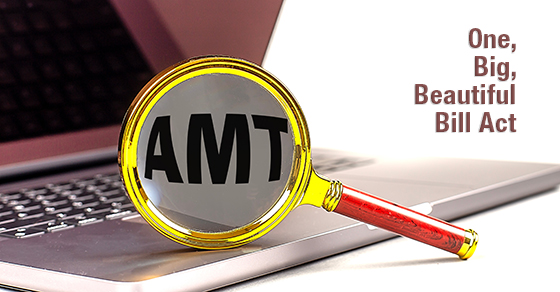What you still need to know about the alternative minimum tax after the new law

The alternative minimum tax (AMT) is a separate federal income tax system that bears some resemblance to the regular federal income tax system. The difference is that the individual AMT system taxes certain types of income that are tax-free under the regular system. It also disallows some deductions that are allowed under the regular system. If the AMT exceeds your regular tax bill, you owe the larger AMT amount.
Tax law changes
The Tax Cuts and Jobs Act (TCJA) made the individual alternative minimum tax (AMT) rules more taxpayer-friendly for 2018-2025 and significantly reduced the odds that you’ll owe the AMT for those years. But the new One Big Beautiful Bill Act (OBBBA) contains mixed news about your AMT exposure.
AMT rates
The maximum AMT rate is “only” 28% versus the 37% maximum regular federal income tax rate. At first glance, it may seem counterintuitive that anyone would worry about paying AMT. However, while the top AMT rate is lower, it applies to a much larger taxable base with fewer deductions and credits. That’s why people in certain situations still need to worry about it.
For 2025, the maximum 28% AMT rate kicks in when your taxable income, calculated under the AMT rules, exceeds an inflation-adjusted threshold of $239,100 for married joint-filing couples or $119,550 for other taxpayers. Below these thresholds, the AMT rate is 26%.
AMT exemptions
Under the AMT rules, you’re allowed an inflation-adjusted AMT exemption — effectively a deduction — in calculating your alternative minimum taxable income. The TCJA significantly increased the exemption amounts for 2018-2025. The OBBBA made the TCJA increased exemption amounts permanent, with annual inflation adjustments.
For 2025, the exemption amounts are $88,100 for unmarried individuals, $137,000 married joint-filing couples, and $68,500 for married individuals who file separate returns.
Exemption phase-out rule
At high levels of alternative minimum taxable income, your AMT exemption is phased out, which increases the odds that you’ll owe the tax. The TCJA dramatically increased the phase-out thresholds to levels where most taxpayers are unaffected by the phase-out rule. For 2025, the exemption begins to be phased out when alternative minimum taxable income exceeds $626,350 or $1,252,700 for a married joint-filing couple. For 2018-2025, the applicable exemption is reduced by 25% of the excess of your alternative minimum taxable income over the applicable phase-out threshold.
Mixed news in the OBBBA
Starting in 2026, the OBBBA makes the $500,000 and $1 million exemption phase-out threshold permanent. That’s the good news.
The bad news: Starting in 2026, the new law resets the exemption phase-out thresholds to $500,000 and $1 million with annual inflation adjustments for 2026 and beyond. So for 2026, these phase-out thresholds will be lower than the higher thresholds that apply for 2025. More bad news: Starting in 2026, the OBBBA increases the exemption phase-out percentage from 25% to 50%.
Bottom line: For 2026 and beyond, AMT exemptions for higher-income taxpayers can be phased out faster. That means more taxpayers may owe the AMT for 2026 and beyond.
AMT risk factors
Various interacting factors make it difficult to pinpoint exactly who’ll be hit by the AMT and who’ll dodge it. Here are five implications and risk factors.
- Substantial income from capital gains or other sources. When you have high income, from whatever sources, it can cause your AMT exemption to be partially or completely phased out. That increases the odds that you’ll owe the AMT.
- Itemized state and local tax (SALT) deductions. You can’t deduct SALT expenses under the AMT rules. This can hurt those living in high-tax states.
- Exercise of incentive stock options (ISOs). When you exercise an ISO, the bargain element (the difference between the market value of the shares on the exercise date and your ISO exercise price) doesn’t count as income under the regular tax rules, but it counts as income under the AMT rules.
- Standard deductions. Standard deductions are disallowed under the AMT rules.
- Private activity bond interest income. This category of interest income is tax-free for regular tax purposes but taxable under the AMT rules.
Determine your status
The TCJA significantly reduced the odds that you’ll owe the AMT. But the OBBBA increases the odds for some taxpayers, thanks to unfavorable changes to the AMT exemption rules that will take effect in 2026. Don’t assume you’re exempt from AMT — especially if you have some of the risk factors outlined above. Contact us to determine your current status after the OBBBA changes take effect.
© 2025

